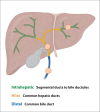Update on the Screening, Diagnosis, and Management of Cholangiocarcinoma
- PMID: 38680168
- PMCID: PMC11047158
Update on the Screening, Diagnosis, and Management of Cholangiocarcinoma
Abstract
Cholangiocarcinoma (CCA) is a neoplasm of the biliary tract that has become increasingly prevalent throughout the world. Common risk factors for developing CCA include cirrhosis, primary sclerosing cholangitis, and trematode fluke infestation, although there are no set screening guidelines in high-risk groups. Lesions are typically identified via cross-sectional imaging and/or elevated serum carbohydrate antigen 19-9 levels, often followed by cytology or brushings with fluorescence in situ hybridization for confirmation. Treatments can vary among CCA subtypes but frequently involve systemic therapies such as gemcitabine and cisplatin with durvalumab or pembrolizumab. Targeted therapies may also be effective (eg, ivosidenib, pemigatinib, infigratinib, futibatinib) depending on the molecular alterations present. Resection is the most common surgical treatment for CCA, although liver transplantation is also an option in highly selected patients with liver-limited unresectable disease. Radiotherapy may also be a treatment option, as well as transarterial radioembolization (eg, yttrium-90), which is often utilized in combination with systemic therapy. Although patients with CCA have traditionally had a poor prognosis, recent advances in treatment, including new systemic therapies and increased utilization of liver transplantation, have improved expected survival. This article reviews screening modalities, pros and cons of diagnostic techniques, and therapies that are currently available to treat patients with CCA.
Keywords: Cholangiocarcinoma; bile duct neoplasms; distal cholangiocarcinoma; hilar cholangio-carcinoma; intrahepatic cholangiocarcinoma.
Copyright © 2024, Gastro-Hep Communications, Inc.
Figures
References
-
- Sithithaworn P, Yongvanit P, Duenngai K, Kiatsopit N, Pairojkul C. Roles of liver fluke infection as risk factor for cholangiocarcinoma. J Hepatobiliary Pancreat Sci. 2014;21(5):301–308. - PubMed
-
- Bertuccio P, Malvezzi M, Carioli G et al. Global trends in mortality from intrahepatic and extrahepatic cholangiocarcinoma. J Hepatol. 2019;71(1):104–114. - PubMed
LinkOut - more resources
Full Text Sources
Miscellaneous


